Norms of the analysis of blood, decoding, the reasons of increase and decrease in indicators in the table.
Contents of the
- The general analysis of the blood( UAC) in children - the norm and the interpretation of the results: table
- Biochemical analysis of blood in children - interpretation and norm in the table
- Clinical analysis of blood in children - decoding and norm in table
- Analysis of blood for tuberculosis for a child instead of Mantoux
- Blood test for allergens in children
- Blood test for children's worms
- Blood test for leukemia in children
- Blood test for lamblias in children
- Blood sugar test for children
- Blood test for the Epstein-Barr virus whenmononucleosis in children
- Analysis for lead in blood in children
- Blood test for hidden infections in children
- How to pass an analysis on whooping cough to a child?
- Staphylococcus aureus in children
- Blood test for scarlet fever in children
- Blood test for chickenpox in children
- Blood test for appendicitis in children
- Mycoplasma test in children
- Blood test for chlamydia in children
- Blood test for rickets in children
- Analysis of ASOin children
- MCHC blood test transcriptional norm in children
- Analysis for growth hormone in children
- Video: How can a virus or bacterial infection in a child be determined from a blood test?
The baby's blood is a good indicator of his health. Therefore, any, even planned inspection of a small person usually ends with a blood test.
It is these results that give the pediatrician the most accurate information about what is happening inside the patient's body.
The general analysis of the blood( UAC) in children is the norm and the interpretation of the results: table
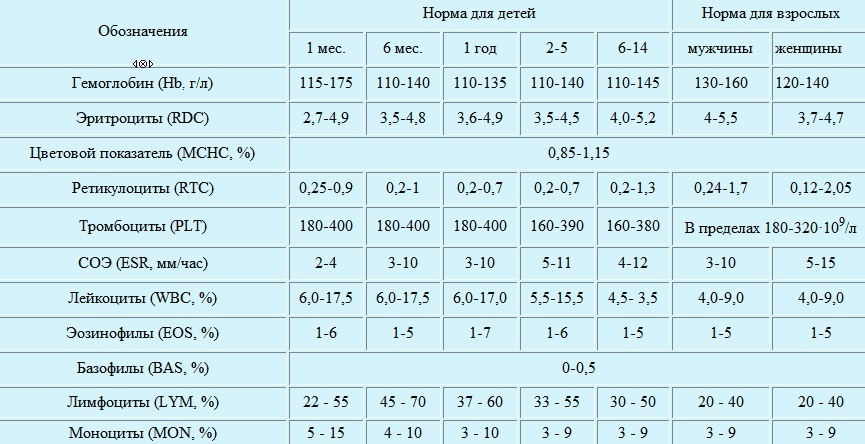 Explanation of the results of the
Explanation of the results of the ASA To understand how correctly to decipher the general blood test, it is necessary to know what indicators help to do this. But remember, all the data given below, we provide for informational purposes only, after all, only a qualified specialist can put the correct diagnosis on these results.
So:
- Erythrocytes. Show how much blood cells are present in the blood of a child
- Reticulocytes. Are responsible for the proper operation of the bone marrow
- Hemoglobin. Protein, which binds oxygen and fills them with absolutely all cells of the body
- Hematocrit. Shows the exact ratio of red blood cells to blood
- Color index. Shows how intensively colored the blood cells are
- Leukocytes. These rates are responsible for the immunity of
- Platelets. Displays the clotting power of blood cells
Biochemical blood test in children - interpretation and norm in table
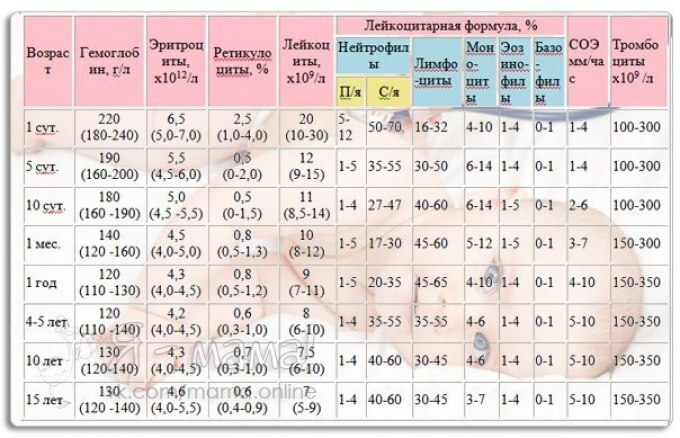 Decoding of biochemical research indicators
Decoding of biochemical research indicators Biochemical blood analysis, in contrast to UAC, is assigned to diagnose a specific disease. Most often with its help identify diseases that in the first stage occur with minimal symptoms.
Key to decoding:
- Protein. Responsible for transportation of biologically active substances
- Albumins. Supports the pressure of a small person
- Globulins in normal state. Help to properly work the immune system
- Bilirubin is common. A substance that appears as a result of the breakdown of hemoglobin
- Bilirubin is free. This indicator is used to diagnose jaundice
- Glucose. Responsible for carbohydrate metabolism in the body.
- Urea. It appears due to the breakdown of proteins and is an indicator of problems with the kidneys
- Creatine. Stimulates qualitative energy metabolism in muscle tissues
Clinical blood test in children - interpretation and norm in table
 Decoding of clinical analysis
Decoding of clinical analysis A clinical blood test is a special method of diagnosis, which makes it possible to notice the development of a disease at an early stage. With its help you can see in what state the immune system of the baby is, and also understand where and why inflammatory processes occur.
In addition, clinical analysis allows specialists to understand at what stage the disease is located and what measures will help to quickly eliminate it.
Analysis of blood for tuberculosis to a child instead of Mantoux
- Although Mantoux test is a very safe procedure, some parents are very afraid of it and categorically refuse to do it to their child. But according to our legislation, children without this research can not attend kindergartens and schools
- Therefore, such parents have to use for diagnosis other, safer, as they think methods. One of them is a blood test for tuberculosis. In this case, your child will take the blood in a standard way and add it to a test tube with a substance that will separate the cellular plasma from
- . The plasma will then be examined under a microscope and if at least the products of Koch's decay are found, the child will be treated adequately
Analysisblood on allergens in children
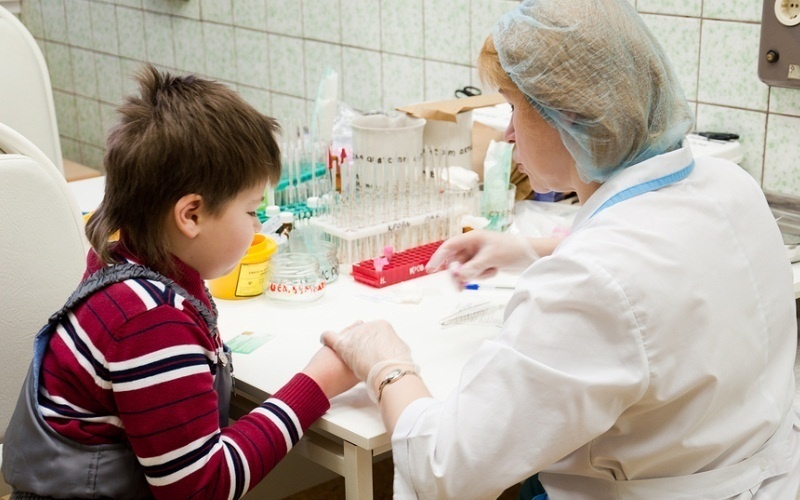 Detect allergens in the blood
Detect allergens in the blood - The immune system of small children is very unstable, so a lot of substances their body perceives with antibodies and accordingly begins to fight them. As a result, children develop nasal congestion, tearing and an itchy rash almost all over the body.
- And if the body of an adult can fairly quickly cope with all these symptoms, then the body of a small person is suffering an allergy heavily. Therefore, it is extremely important to determine in time what provokes an allergic reaction in the baby and try to get rid of it as quickly as possible. Usually, small children take blood for allergens
- for this purpose. This method is considered more optimal for them, as in contrast to the skin test is less painful and has no contraindications. The most pleasant thing is that one blood sampling helps to identify all pathogens of allergy
. The analysis of blood for worms in children
- The time has long gone when to reveal the presence of worms in the orgasm of a child could only be an analysis of feces. Now more and more parents prefer immune-enzyme analysis of blood. This diagnostic method gives a more accurate result, and also helps the doctor to understand what harm has already been inflicted on the body by
- worms. Another advantage of this blood test is that during treatment, pediatricians can monitor whether the parasites have stopped multiplying and how many remain inside the body. But in order for the analysis to give the right result to him, you must prepare yourself correctly.
- . One day before the baby's diet is taken, fat and sweet food should be excluded and, if possible, it should not be fed before the blood sampling itself.
Blood test for leukemia in children
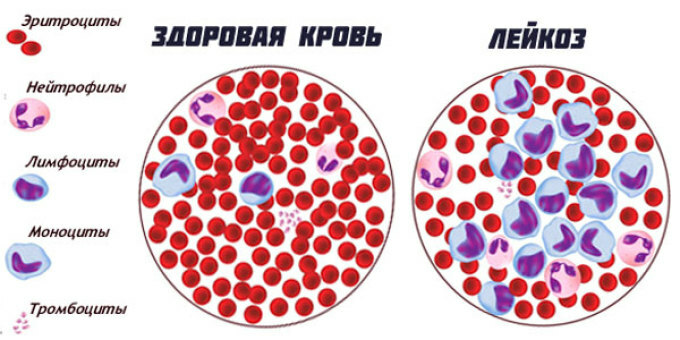 Diagnosis of leukemia
Diagnosis of leukemia - Leukemiaor as it is also called blood cancer, most often manifests itself as the appearance of malignant bodies in the bone marrow of a child. When they get there, they begin to replace the healthy cells very intensively, thereby violating the normal functioning of the child's internal organs. Most of all this pathology affects children 3-4 years
- Identify the disease can even a general blood test. As a rule, if the child develops leukemia, then in his blood the level of hemoglobin falls sharply. Against this background, the capacity of hematopoiesis decreases and the volumes of red blood cells decrease.
- Besides this, eosinophils and basophils completely disappear from the blood composition, which are responsible for the creation of leukocytes. Outwardly, all this can manifest as general weakness, pain in the joints, spine and causeless appearance of bruises
Blood test for lamblia in children
- Lamblias are parasites that usually settle in the thick and thin intestines, the liver and the spleen. These little creatures greatly spoil the life of a young child. As a rule, children infected with these parasites suffer from diarrhea, constipation, nausea and a rather painful meteorism.
- A special blood test done by ELISA will help you to identify lamblia. Immediately I want to say that this method of diagnosis does not directly identify parasites, with its help, the blood is examined for the presence of products of life lamblia. Therefore, to know exactly which body they settled in, it will not exactly help you
- Usually for this pediatricians prescribe additional examinations. Evidence that your baby is infected with lamblia will be the appearance in his body of antibodies IgG
Blood sugar test for children in children
 Detecting an increase in blood glucose
Detecting an increase in blood glucose - Since glucose is a fairly important consumable, its decrease or increase immediately affects the overall performance of the wholeorganism. If we talk about children, the glucose values in their blood can vary several times a day.
- Therefore, if you want to get the most reliable result, then do this examination in the morning and be sure on an empty stomach. Ideally, a child, in general, should not eat 12 hours before taking blood. As a rule, biochemical analysis of
- is done to measure blood glucose level. Literally the next day you will be able to get results and immediately show them to the doctor. If the indices exceed 6.1 mmol / liter or drop below 2.5 mmol / liter, your child will be referred for consultation to the endocrinologist and he will decide what caused the pathology
Blood test for the Epstein-Barr virus in mononucleosisin children
- The Epstein-Barr virus provokes such a serious disease as mononucleosis. At the initial stage, this disease manifests itself as a banal angina, which is very quickly aggravated and the lymphatic system, liver and spleen
- is affected. Therefore, if in addition to the standard symptoms of angina you still have pain in the area of lymph nodes and the spleen, then immediately give a biochemical blood test. It will definitely help you to find out whether there is an Epstein-Barr virus in your body or not.
- Usually, if a person develops mononucleosis, then the blood levels of single-nucleated white blood cells and monocytes increase quite significantly. As soon as it becomes clear how much blood cells are overestimated, the doctor will be able to explain whether you are a carrier of the disease, whether you are harmless to others and whether mononucleosis has passed to the chronic stage.
Analysis for lead in blood in children
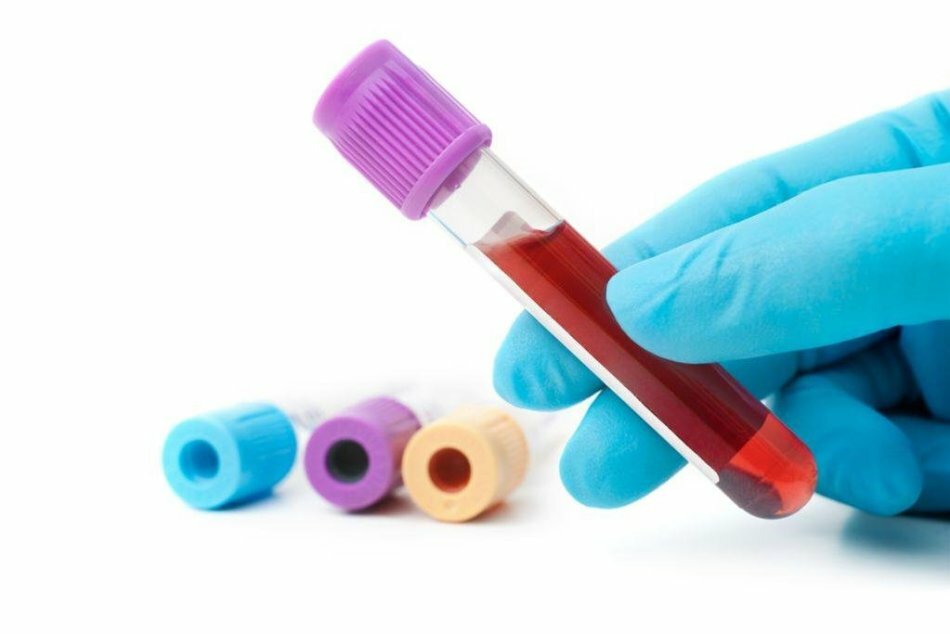 Blood to detect lead in a child's blood
Blood to detect lead in a child's blood - lead in children's blood should not exceed 8-9 μg per deciliter. If they even rise slightly, the child will begin to intoxicate the body. The most unpleasant thing is that for the time being you may not even know that your baby was poisoned with lead
- . But the more harmful metal will settle in the blood of the crumbs, the stronger and more vivid the symptoms become. Identify a similar problem can be even without any complicated research. You can pass a clinical blood test and, by its results, understand why you have a reason to worry.
- . If it shows that the blood level is critically lowered, you will additionally have to do atomic-absorption spectrometry. In this case, the study will need venous blood already.
. Blood test for hidden infections in children.
- . Bacteria that provoke childhood illnesses can for a while quietly live in the body of a child and do not make itself felt. But as soon as the immunity of the baby is critically reduced, they will begin to multiply intensively and cause inflammatory processes inside the body.
- On this attentive parents can signal the hidden symptoms. Such babies can very quickly get tired, fall asleep almost on the go or simply be whimsical. If your baby has a hidden infection, then he can begin to feel bad 10-14 days before the appearance of the main symptoms of the disease.
- . In case the child has similar problems, the child will immediately have a white blood cell level in the blood. Neutrophils will also rise slightly and the erythrocyte sedimentation rate will increase.
How to pass an analysis on whooping cough to a child?
 Diagnosis of whooping cough in the blood of a child
Diagnosis of whooping cough in the blood of a child - Pertussis is a pretty insidious disease, which is difficult to diagnose. At the initial stage, it can be similar to bronchitis or asthma. Therefore, at first pediatricians may be limited to a general blood test and therapy that will stimulate sputum smearing
- But if the child's coughing becomes very severe and becomes paroxysmal, then an enzyme immunoassay can be prescribed. During this diagnosis, the presence of a specific protein in the blood that appears in the body due to the vital activity of pertussis causative agent
- is determined if the pathogenic bacteria affected the bronchi and the lungs of the kid, then a laboratory test will show the presence of leukocytosis and lymphocytosis.
Staphylococcus aureus in children
- Staphylococcal blood testgives almost 100% correct result, therefore if you have a suspicion that in an organism of your child the originators of the given disease live, then ask the pediatrician to understandabout the examination of sputum and examination of mucous to appoint your child another biochemical blood test
- In this case, specialists will apply the reaction of direct hemagglutination and ELISA.But remember, if you want to get the most reliable result, then 10 days before blood collection stop giving your child antimicrobial drugs
- A large concentration of these substances in the blood of a child can sufficiently reduce the reliability of the study. Because of this, the doctor will not be able to accurately understand at what stage the disease is, and therefore the treatment may not be prescribed correctly
Blood test for scarlet fever in children
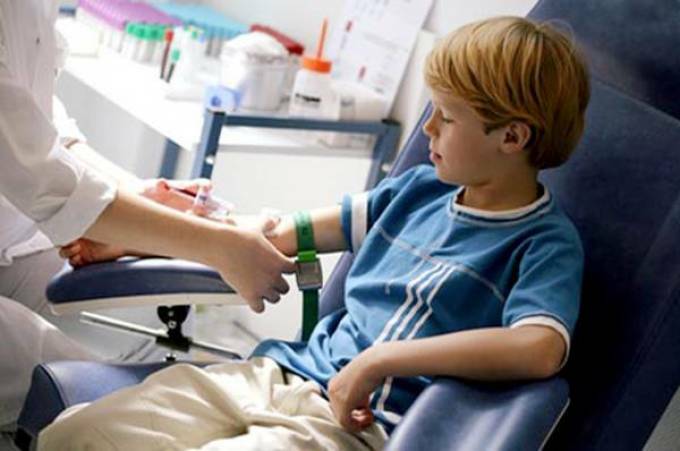 Detection of the causative agent of scarlet fever in the child's blood
Detection of the causative agent of scarlet fever in the child's blood Although scarlet fever almost always has pronounced symptoms, doctorssometimes reinsured and appoint a small patient a general blood test. So they try to exclude the possibility of such diseases as rubella, measles and pseudotuberculosis, and try to understand what damage the pathology has already managed to inflict on the baby.
In scarlet fever, acute leukocytosis usually develops( the level of leukocytes increases) and blood begins to coagulate very quickly. As a rule, this leads to the fact that the crumb increases the risk of blood clots. In addition, there is a fairly noticeable shift in the leucoform to the left. Such indicators suggest that the disease is in the acute phase and it should be treated with antibiotics.
Blood test for chickenpox in children
- Chickenpox refers to diseases that are almost always very acute. For this reason, the causative agent of this disease, literally a couple of hours after infection, begins to exert a very strong influence on the baby's blood.
- . If the child has a general blood test, he will show that he has a very low level of leukocytes and increased levels of lymphocytes. Also, the level of SOE may slightly increase. In the event that the disease will proceed with the consequences, the child will necessarily have to do another biochemical blood test.
- Only with his help can one find out whether the wind chicks of the kidney have suffered and how correctly they perform their purifying function. If the chickenpox virus has infected them, then in the analysis it will be reflected by a decrease in platelets and an increase in some enzymes.
A blood test for appendicitis in children
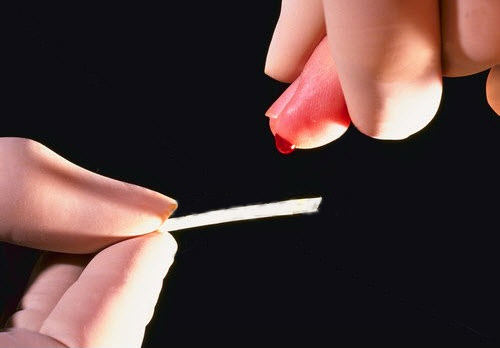 A blood test for appendicitis
A blood test for appendicitis In principle, if a small patient has all the symptoms of appendicitis, then no tests may be needed. But, to my great regret, most often it is in small children that they are sufficiently razed or, in general, atypical. For this reason, doctors are always reinsured and prescribe additional diagnosis to patients. OAK is most often used for this.
The main indicator that the child has an inflammation of the appendix is an elevated level of white blood cells. In addition, special attention is paid to the leukocyte formula. If its indicators are also changed( there is a predominance of free white blood cells), then this indicates that the child's body is quite a serious inflammatory process.
Mycoplasma analysis in children
- Mycoplasmosis is considered quite an insidious disease, as it can be asymptomatic at first, and only when the disease passes to the acute stage, the first signs of infection begin to appear. In order to find out whether your baby is infected or not, you just need to give him an enzyme-linked immunosorbent assay
- They will help you determine whether the child's body produces specific antibodies that fight the pathogen of mycoplasmosis. If the presence of the disease is confirmed, you will need to conduct an additional blood test. This time the diagnosis will be carried out by the PCR method
- It will give a more accurate picture of the development of mycoplasmosis as it can isolate the pathogen DNA and tell at what stage the disease is located.
Blood test for chlamydia in children
- It is possible to diagnose the presence of chlamydia in the child's bodythe same enzyme immunoassay. With its help, an experienced lab technician should determine which antibodies are currently producing the immune system of a small patient( IgA, IgM, IgG), and on the basis of these data, it is concluded how much chlamydia had time to harm a child.
- Approximately in the middle of treatment therapy,.This will give an opportunity to your doctor to understand whether to reduce the amount of antibodies in the blood and whether the medication treatment has the right effect
- . And remember, very quickly you will not be able to get rid of chlamydia, so adjust yourself and your baby to what you need for a whiledensely engage in his health and periodically check blood for the presence of gene material excite chlamydia
Analysis of blood for rickets in children
- Rickets can develop very quickly, sometimes from the first symptoms and to the very firstThe phase trip takes just a few weeks. And since these diseases most often affect children under two years, the only accurate method of diagnosis is the biochemical study of the blood
- Surrender it to an empty stomach and preferably in the morning. Since in the first half of the day all metabolic processes in the child's body go much faster than in the second, it will allow to get a more complete picture. This diagnosis should show at what level the values of phosphorus, potassium, calcium and alkaline phosphatase
- are located. If at least one substance does not show a norm, this will indicate that the baby develops rickets
Analysis of ASLO in children
 Analysis of ASLO
Analysis of ASLO Most often diagnosingwith the help of ASLO is carried out to identify rheumatism in the body. But in the case of children, the study can be conducted to determine the stage of the disease caused by hemolytic streptococci. This can be, for example, angina or glomerulonephritis. Especially if they occur with complications. Venous blood taken on an empty stomach is necessary for ASLO.
If in the child's body there are acute pathological changes, ASLO will show an increase in ESR and C-reactive protein. If we talk about the C-reactive protein, then depending on the disease, its indices can shift to one or the other. Usually, in bacterial diseases, the level of CRP is much higher than in viral.
MCHC blood test transcriptional norm in children
ICSU is an erythrocyte index that shows us in what state the blood cells are and how much they contain hemoglobin. These figures are measured in grams per liter. Depending on the age of the child, they can vary from 280 to 380 g / l. Usually in newborn babies these figures do not rise higher than 330 g / l.
But the older the child becomes, the larger the erythrocyte index becomes. In a one-year-old child, he can increase already 350 g / l, and after six to 380 g / l. Immediately I want to say that boys ICSU usually slightly higher than girls. If the level of red blood cells falls, then this is evidence of the development of anemia.
Analysis for growth hormone in children
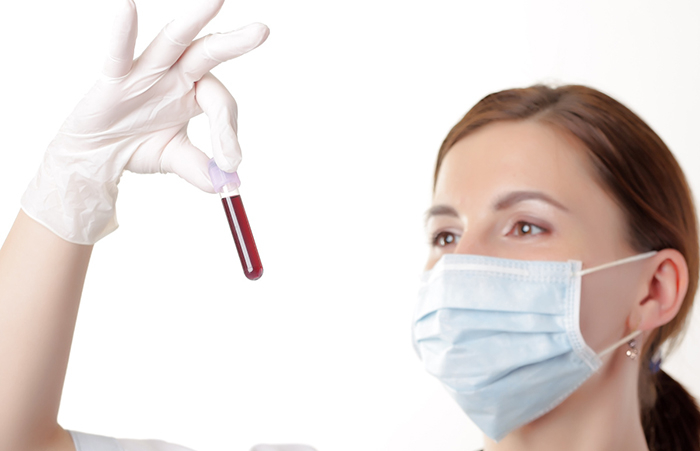
- Hormones are substances that participate in virtually all vital processes of our body. Therefore, if indicators fall or rise, this immediately affects our health. For the growth and development of the child's organism, the hormone somatotropin
- responds. If this substance does not work out in the right amounts, then the child stops growing normally. In the case of an excess of somatotropin in the body, a baby can grow much faster than its peers. If you see that your child has any abnormalities in growth, then be sure to show it to the endocrinologist
- . In children, the values of growth hormone can range from 5-14 μg /.All that will fall below this mark or will rise higher is considered pathologies. It is likely that in the event of a deviation from normal performance, a specialist will propose that your child receive treatment therapy that will normalize the amount of somatotropin in the body.
